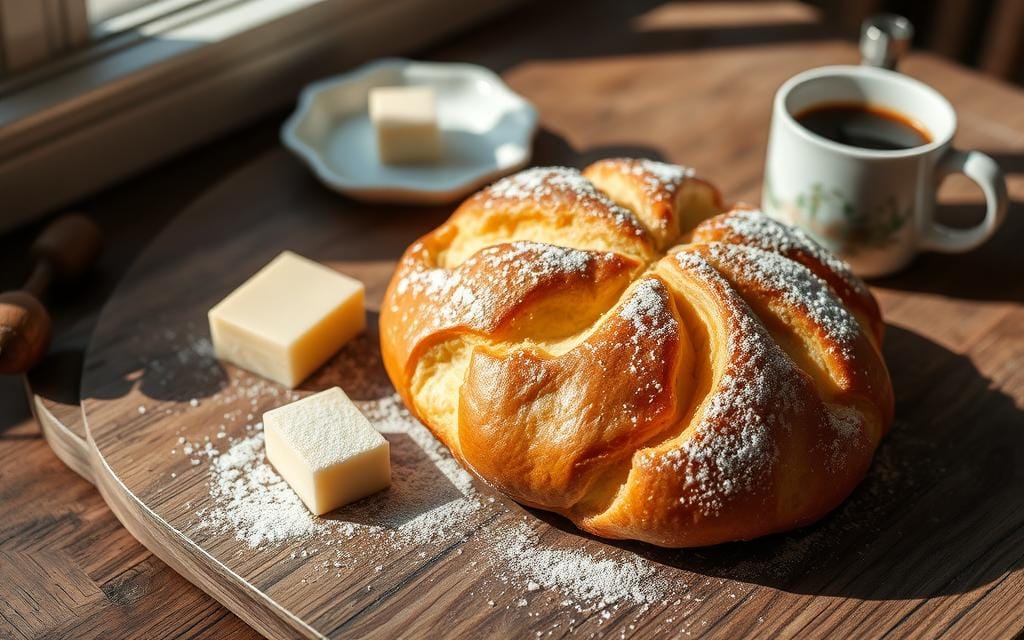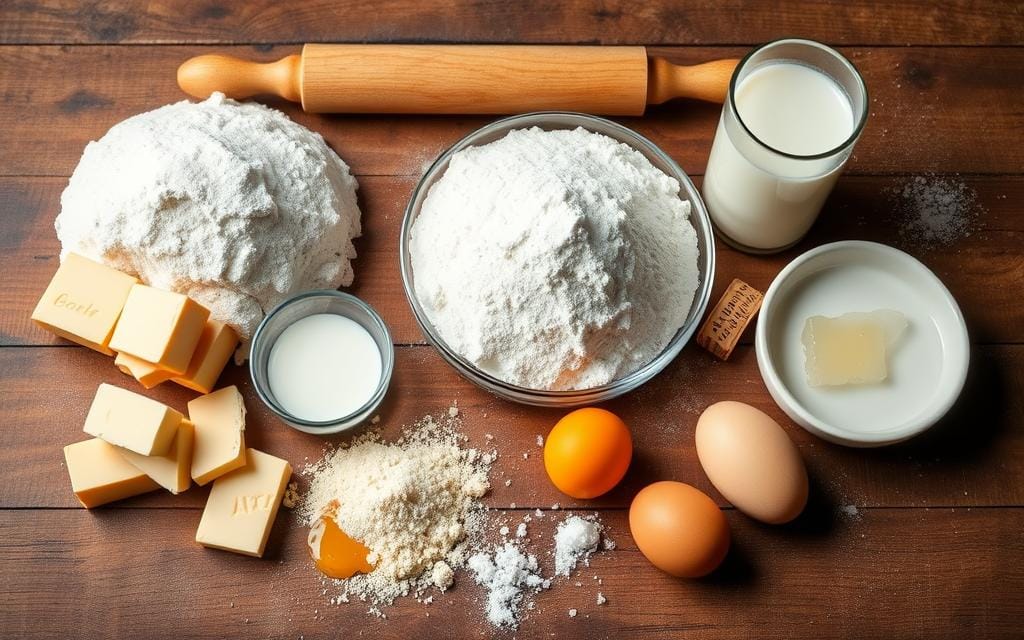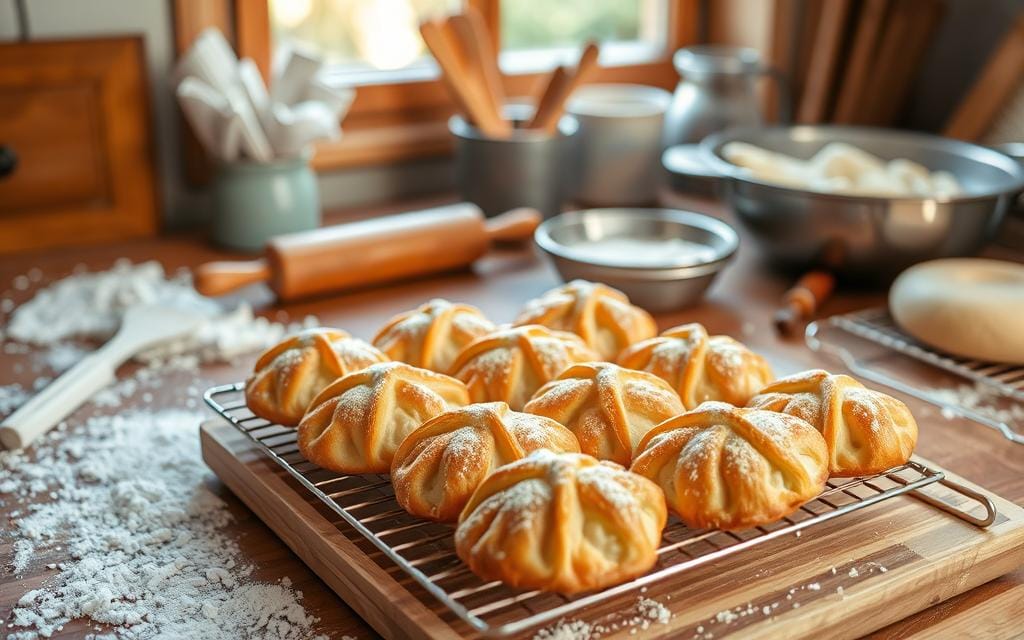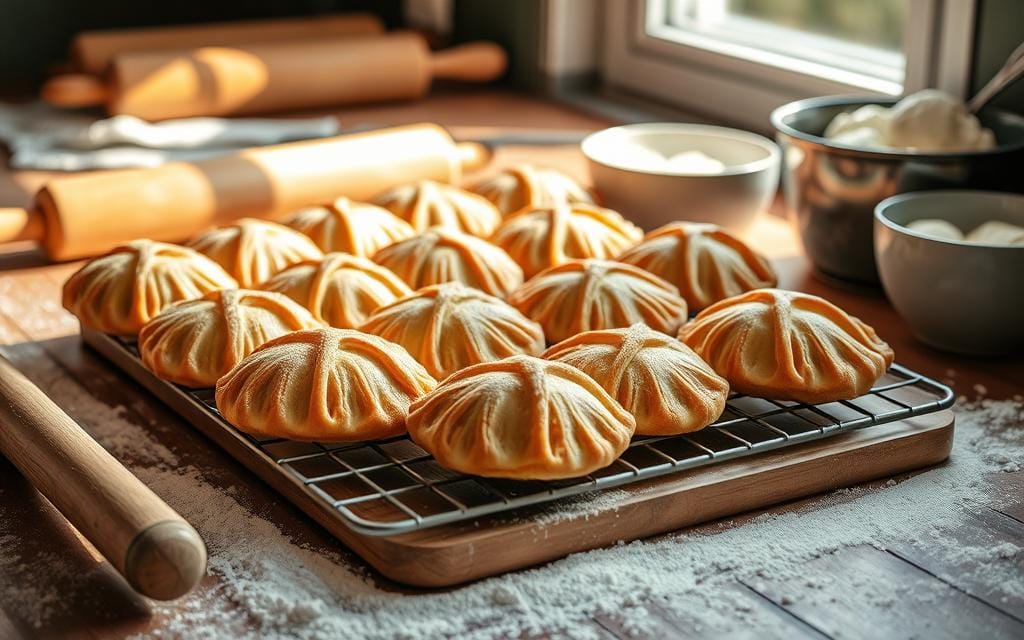Imagine waking up to the scent of freshly baked, golden pastries. Their flaky layers hide a tasty surprise. This is the charm of the Swiss gipfeli recipe, a beloved breakfast treat. As a Swiss-American, I cherish the memories of enjoying these crescent-shaped treats. Their buttery taste is unforgettable.
In this guide, I’ll reveal how to make an authentic gipfeli recipe at home. Whether you’re an experienced baker or new to pastries doesn’t matter. You’ll get precise instructions and helpful tips to make these Swiss croissants yourself. Prepare to start a tasty adventure and enjoy Swiss flavors at home.
Table of Contents
Understanding Swiss Gipfeli Recipe: A Traditional Breakfast Pastry
Gipfeli, the Swiss version of croissants, is loved in Switzerland. They have a long history, dating back to the 19th century. These pastries are a key part of Swiss breakfasts and coffee breaks.
Swiss gipfeli are denser and less buttery than French croissants. They have a crispy crust and a soft, pillowy inside. If you love versatile pastries, don’t miss these puff pastry recipes, perfect for any occasion.
The History Behind the Swiss Gipfeli Recipe
The Swiss gipfeli started in the 19th century as a breakfast favorite. They are made with flour, milk, butter, yeast, sugar, and salt. The dough is folded and chilled several times to get the flaky layers.
Differences Between Gipfeli Recipe and French Croissants
Gipfeli and French croissants look similar but taste and feel different. Gipfeli have more butter, making them richer and crunchier. The dough for gipfeli is rested and chilled for a unique texture and shape.
Cultural Significance of the Gipfeli Recipe in Swiss Cuisine
Swiss gipfeli are a big part of Swiss culture. You can find them in bakeries and cafes across Switzerland. They are enjoyed with coffee or tea and show Swiss hospitality and baking traditions.
Pairing gipfeli with sweet fillings or dessert-like options? You may enjoy incorporating ideas from perfect chocolate croissants at home to add a luxurious twist.

“Gipfeli are a quintessential part of the Swiss breakfast experience. The aroma of freshly baked gipfeli wafting through the air is enough to make anyone’s mouth water.”
Exploring Zurich, the Swiss Alps, or just enjoying a treat? Try the Swiss gipfeli. It’s a must for those who love traditional Swiss breakfasts, gipfeli vs croissants, and Swiss baking.
Essential Ingredients for the Perfect Gipfeli Recipe
To make the ultimate Swiss gipfeli recipe, you need the right ingredients. Start with all-purpose flour or bread flour for the base. European-style butter with more fat is key for a flaky, rich taste.
If you’re seeking seasonal inspiration, pair the buttery layers of the gipfeli recipe with an easy peach cobbler recipe.
Whole milk adds creaminess, and sugar gives a hint of sweetness. Active dry or instant yeast makes it rise beautifully. A bit of salt boosts the flavor, and an egg wash makes it golden.
Want to add something special? Try chocolate, nut paste, cheese, or ham fillings. Try gluten-free flour, plant-based butter and milk, or whole wheat flour for different tastes.
“The secret to a perfect gipfeli lies in the quality of the ingredients and the precise technique of lamination.”
With these ingredients, you’re ready to bake like a pro. You’ll bring a bit of Switzerland into your kitchen.
Key Ingredients for Gipfeli
- 500g all-purpose flour or bread flour
- 250ml warm whole milk
- 50g sugar
- 1 packet of active dry yeast
- 1 tsp salt
- 250g cold unsalted butter
- 1 beaten egg for brushing

Kitchen Equipment for Your Gipfeli Recipe
To make perfect Swiss Gpfeli at home, you need some key baking tools and equipment. Essential items like mixing bowls and a rolling pin are required, but you’ll also need specialized tools to get the best results.
Essential Baking Tools
- Mixing bowls in various sizes
- A sturdy rolling pin for shaping the dough
- A pastry brush for applying egg wash or other glazes
- Baking trays or sheets lined with parchment paper
Optional Equipment for Better Results
While you can’t skip the essential tools, some extra equipment can improve your Gipfeli baking:
- Kitchen scales for precise ingredient measurements
- A dough scraper or cutter to help with the lamination process
- A stand mixer with a dough hook attachment for kneading the dough
Preparation Surface Requirements
A clean, flat, and calm surface is key for rolling and shaping the dough. You’ll need a large, uncluttered counter or table. A marble or granite surface is best for keeping the right temperature during lamination and folding.
Having the right baking tools, gipfeli equipment, and pastry making tools. With the right tools and a well-prepared work surface, you’ll be on your way to making delicious Swiss Gipfeli at home.
Mastering the Gipfeli Dough Preparation
Making the perfect gipfeli dough is key to these tasty Swiss pastries. It’s all about activating the yeast dough recipe and mixing the ingredients, ensuring the dough turns out just right.
Begin by proofing the yeast in warm milk. This will allow the yeast to start working and making the dough rise. Next, mix the dry ingredients—flour, sugar, and salt—together. Then, add the proofed milk and knead the gipfeli dough until it’s smooth and elastic.
- Proof the yeast in warm milk for 5-10 minutes until frothy.
- Whisk together the flour, sugar, and salt in a large bowl.
- Slowly add the proofed milk mixture to the dry ingredients, kneading until a smooth, elastic dough forms.
- Cover the dough and let it rise for 1-2 hours or until it doubles in size.
It’s important to knead and rest the dough well. This helps the dough’s structure and taste come together. After it rises, you’re ready for the lamination process.
“The key to perfect gipfeli is in the dough. With the right technique and patience, you’ll be rewarded with layers of buttery, flaky goodness.”
The Art of Lamination in the Gipfeli Recipe
Mastering pastry lamination is key to flaky Swiss Gipfeli layers. This process involves encasing butter in the dough and rolling and folding it. Gipfeli lamination needs 3-4 turns, with 30-minute rests to relax the dough and chill the butter.
Understanding the Butter Layer Technique
The butter layer technique is the heart of lamination. It is important to use just the right butter—not too soft or hard. This balance is crucial for Gipfeli’s flaky texture and feel.
Step-by-Step Folding Process
- Roll the dough into a rectangle, then place the butter block in the center.
- Fold the dough over the butter, making a package.
- Roll the package into a longer rectangle, then fold it into three parts.
- Repeat the rolling and folding 2-3 more times, resting the dough in the fridge between turns.
Common Lamination Mistakes to Avoid
- Using too soft or too hard butter can lead to uneven lamination and dough tearing.
- Overworking the dough can compromise the delicate layers, creating a rugged, chewy texture.
- Insufficient resting time between folds causes the butter to melt and the dough to become challenging to work with.
Mastering the butter layer technique and perfecting the folding process will help you make the flakiest, most irresistible Swiss Gipfeli at home.
Shaping and Proofing Your Gipfeli Recipe
Making the perfect Gipfeli recipe requires a gentle touch of shaping and proofing. After the dough is laminated, it’s time to shape it into the famous crescent shapes. Let’s look at how to get this Swiss baking hallmark right.
Start by rolling the dough into a big rectangle. Then, cut it into triangular pieces with a sharp knife or pizza cutter. Shaping pastry is an art, so roll each triangle into a crescent shape.
- Put the shaped Gipfeli on a parchment-lined baking tray, leaving space for them to proof without touching.
- Cover them with a clean, damp towel or plastic wrap and let them proof for 30-45 minutes. This step allows the crescent-shaped pastries to rise and develop their flaky texture.
“The key to perfect Gipfeli is in the delicate balance of shaping and proofing. With a light touch, you can create these delightful Swiss delicacies in your own kitchen.”
While the Gipfeli proof, they will puff up and get bigger. Please don’t rush this step, as it’s crucial for their flaky, buttery taste. With patience and care, you can bake authentic Swiss Gipfeli at home.
Baking Techniques for the Gipfeli Recipe
Focus on oven temperature and baking time to get the perfect golden-brown crust on your homemade gipfeli. It’s all about finding the right balance of crispy outside and soft inside.
Temperature and Timing Guidelines
Gipfeli are baked at 375°F (190°C) for 15 to 18 minutes. This temperature is just right for the pastry crust techniques to work magic. It results in a golden-brown pastry that’s simply irresistible.
Place the baking tray in the middle of the oven to achieve even browning. An egg wash before baking makes the crust shiny and perfectly crisp.
Creating the Perfect Crust
The Maillard reaction, discovered by French chemist Louis Camille Maillard in 1912, is key to Gipfeli’s amazing aroma and color. It happens when the dough hits at least 280°F, caramelizing sugars and proteins.
“The Maillard reaction produces more attractive and flavorful food compared to other types of browning like caramelization.”
Avoid steaming the dough to maximize the Maillard reaction. By controlling the oven temperature and time, you can achieve a perfect crispy and soft crust.

Creative Filling Ideas for Your Gipfeli Recipe
Make your homemade gipfeli recipe memorable with tasty fillings and serving ideas. They’re not just for butter or chocolate. You can turn them into sweet or savory treats that will amaze you.
For a savory option, consider pairing the gipfeli recipe with seafood dishes like healthy and simple rockfish recipes.
For a classic treat, try nut pastes or fruit preserves. Almond or hazelnut spreads add a rich flavor to the dough. Fill them with raspberry, apricot, or strawberry preserves for a fruity twist.
Want something savory? Use cheese-based fillings in your gipfeli. Mix cream cheese with feta and spinach for a tasty surprise. Add mozzarella, gouda, or gruyere on top for a cheesy delight.
“The possibilities for gipfeli fillings are endless, from sweet to savory. Get creative and experiment with your favorite flavors!”
Gipfeli is excellent for any time of day. Enjoy them with coffee or tea in the morning or iced tea or lemonade in the afternoon. They’re also perfect for brunch with sweet and savory dishes.

Whether you stick to traditional fillings or try new ones, gipfeli will impress. Use these ideas to make your homemade gipfeli even better. Enjoy a taste of Switzerland right in your kitchen.
Conclusion
Learning to make homemade gipfeli, a Swiss pastry, lets you try different flavors. It takes patience and precision, but the result is worth it. You’ll get a flaky pastry that’s as good as those in Swiss bakeries.
With practice, you can make delicious gipfeli at home. Your kitchen will smell like Switzerland, and your family and friends will love the treats you make.
Knowing the ingredients and lamination technique is the secret to a tremendous gipfeli recipe. Paying attention to the baking process is also key. Follow the baking tips to get a golden-brown crust and flaky texture.
Feel free to try classic fillings or new ones. Making gipfeli at home is fun. It’s a chance to connect with Switzerland’s culinary traditions and impress your loved ones.


1 thought on “How to Make Swiss Gipfeli Recipe at Home”